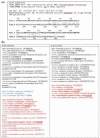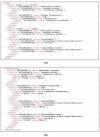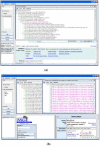DynGO: a tool for visualizing and mining of Gene Ontology and its associations
- PMID: 16091147
- PMCID: PMC1199584
- DOI: 10.1186/1471-2105-6-201
DynGO: a tool for visualizing and mining of Gene Ontology and its associations
Abstract
Background: A large volume of data and information about genes and gene products has been stored in various molecular biology databases. A major challenge for knowledge discovery using these databases is to identify related genes and gene products in disparate databases. The development of Gene Ontology (GO) as a common vocabulary for annotation allows integrated queries across multiple databases and identification of semantically related genes and gene products (i.e., genes and gene products that have similar GO annotations). Meanwhile, dozens of tools have been developed for browsing, mining or editing GO terms, their hierarchical relationships, or their "associated" genes and gene products (i.e., genes and gene products annotated with GO terms). Tools that allow users to directly search and inspect relations among all GO terms and their associated genes and gene products from multiple databases are needed.
Results: We present a standalone package called DynGO, which provides several advanced functionalities in addition to the standard browsing capability of the official GO browsing tool (AmiGO). DynGO allows users to conduct batch retrieval of GO annotations for a list of genes and gene products, and semantic retrieval of genes and gene products sharing similar GO annotations. The result are shown in an association tree organized according to GO hierarchies and supported with many dynamic display options such as sorting tree nodes or changing orientation of the tree. For GO curators and frequent GO users, DynGO provides fast and convenient access to GO annotation data. DynGO is generally applicable to any data set where the records are annotated with GO terms, as illustrated by two examples.
Conclusion: We have presented a standalone package DynGO that provides functionalities to search and browse GO and its association databases as well as several additional functions such as batch retrieval and semantic retrieval. The complete documentation and software are freely available for download from the website http://biocreative.ifsm.umbc.edu/dyngo.
Figures








Similar articles
-
GeneTools--application for functional annotation and statistical hypothesis testing.BMC Bioinformatics. 2006 Oct 24;7:470. doi: 10.1186/1471-2105-7-470. BMC Bioinformatics. 2006. PMID: 17062145 Free PMC article.
-
MILANO--custom annotation of microarray results using automatic literature searches.BMC Bioinformatics. 2005 Jan 20;6:12. doi: 10.1186/1471-2105-6-12. BMC Bioinformatics. 2005. PMID: 15661078 Free PMC article.
-
GeneInfoViz: constructing and visualizing gene relation networks.In Silico Biol. 2004;4(3):323-33. In Silico Biol. 2004. PMID: 15724283
-
Ontology annotation: mapping genomic regions to biological function.Curr Opin Chem Biol. 2007 Feb;11(1):4-11. doi: 10.1016/j.cbpa.2006.11.039. Epub 2007 Jan 5. Curr Opin Chem Biol. 2007. PMID: 17208035 Review.
-
Get ready to GO! A biologist's guide to the Gene Ontology.Brief Bioinform. 2005 Sep;6(3):298-304. doi: 10.1093/bib/6.3.298. Brief Bioinform. 2005. PMID: 16212777 Review.
Cited by
-
GRank: a middleware search engine for ranking genes by relevance to given genes.BMC Bioinformatics. 2013 Aug 19;14:251. doi: 10.1186/1471-2105-14-251. BMC Bioinformatics. 2013. PMID: 23957362 Free PMC article.
-
UFO: A tool for unifying biomedical ontology-based semantic similarity calculation, enrichment analysis and visualization.PLoS One. 2020 Jul 9;15(7):e0235670. doi: 10.1371/journal.pone.0235670. eCollection 2020. PLoS One. 2020. PMID: 32645039 Free PMC article.
-
GO-based functional dissimilarity of gene sets.BMC Bioinformatics. 2011 Sep 1;12:360. doi: 10.1186/1471-2105-12-360. BMC Bioinformatics. 2011. PMID: 21884611 Free PMC article.
-
Semantic similarity in biomedical ontologies.PLoS Comput Biol. 2009 Jul;5(7):e1000443. doi: 10.1371/journal.pcbi.1000443. Epub 2009 Jul 31. PLoS Comput Biol. 2009. PMID: 19649320 Free PMC article. Review.
-
Diabetic Retinopathy and Laser Therapy in Rats: A Protein-Protein Interaction Network Analysis.J Lasers Med Sci. 2017 Summer;8(Suppl 1):S20-S21. doi: 10.15171/jlms.2017.s4. Epub 2017 Aug 29. J Lasers Med Sci. 2017. PMID: 29071030 Free PMC article.
References
-
- Harris MA, Clark J, Ireland A, Lomax J, Ashburner M, Foulger R, Eilbeck K, Lewis S, Marshall B, Mungall C, Richter J, Rubin GM, Blake JA, Bult C, Dolan M, Drabkin H, Eppig JT, Hill DP, Ni L, Ringwald M, Balakrishnan R, Cherry JM, Christie KR, Costanzo MC, Dwight SS, Engel S, Fisk DG, Hirschman JE, Hong EL, Nash RS, Sethuraman A, Theesfeld CL, Botstein D, Dolinski K, Feierbach B, Berardini T, Mundodi S, Rhee SY, Apweiler R, Barrell D, Camon E, Dimmer E, Lee V, Chisholm R, Gaudet P, Kibbe W, Kishore R, Schwarz EM, Sternberg P, Gwinn M, Hannick L, Wortman J, Berriman M, Wood V, de la Cruz N, Tonellato P, Jaiswal P, Seigfried T, White R. The Gene Ontology (GO) database and informatics resource. Nucleic Acids Res. 2004;32:D258–61. - PMC - PubMed
-
- Bult CJ, Blake JA, Richardson JE, Kadin JA, Eppig JT, Baldarelli RM, Barsanti K, Baya M, Beal JS, Boddy WJ, Bradt DW, Burkart DL, Butler NE, Campbell J, Corey R, Corbani LE, Cousins S, Dene H, Drabkin HJ, Frazer K, Garippa DM, Glass LH, Goldsmith CW, Grant PL, King BL, Lennon-Pierce M, Lewis J, Lu I, Lutz CM, Maltais LJ, McKenzie LM, Miers D, Modrusan D, Ni L, Ormsby JE, Qi D, Ramachandran S, Reddy TB, Reed DJ, Sinclair R, Shaw DR, Smith CL, Szauter P, Taylor B, Vanden Borre P, Walker M, Washburn L, Witham I, Winslow J, Zhu Y. The Mouse Genome Database (MGD): integrating biology with the genome. Nucleic Acids Res. 2004;32:D476–81. doi: 10.1093/nar/gkh125. - DOI - PMC - PubMed
-
- Twigger S, Lu J, Shimoyama M, Chen D, Pasko D, Long H, Ginster J, Chen CF, Nigam R, Kwitek A, Eppig J, Maltais L, Maglott D, Schuler G, Jacob H, Tonellato PJ. Rat Genome Database (RGD): mapping disease onto the genome. Nucleic Acids Res. 2002;30:125–128. doi: 10.1093/nar/30.1.125. - DOI - PMC - PubMed
Publication types
MeSH terms
LinkOut - more resources
Full Text Sources

